Hasegawa 1/200 C-130H
|
KIT #: |
10699 |
|
PRICE: |
120 yuan |
|
DECALS: |
Two options |
|
REVIEWER: |
Richard F |
|
NOTES: |
Boxing included two kits. Bestfong
decals. |
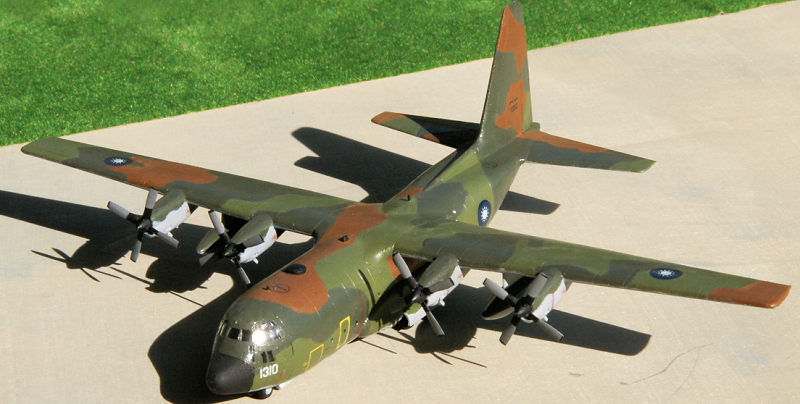
The C-130 is probably the most successful and most versatile cargo plane
ever made. Just about everyone but the Soviets/Russians has used them at one
time or another.
Taiwan, also known as the Republic of China, is one such place. It was
operating C-119s right into the 1980s, until the US provided the first of
what would be 20 C-130Hs in 1986. They came in several batches, the last
being delivered in 1997 (allowing the C-119s to finally be pensioned off!).
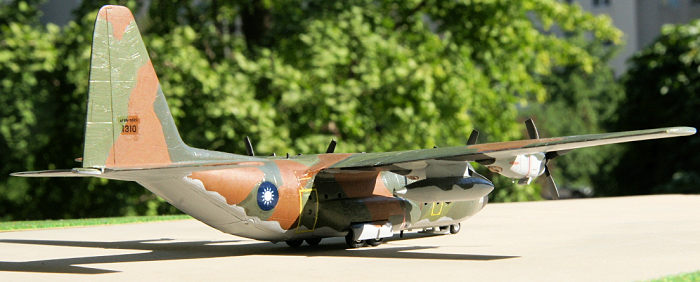 Taiwan is
a pretty small place, so one might ask why it needs 20 C-130s. Well, one was
converted to an electronic warfare platform, which makes sense, and of
course every air force needs to move cargo from base to base. Spare parts
here, crew there, and so on. The C-130s could be fitted as tankers, but this
is a touchy subject with the People's Republic of China (PRC) which, of
course, claims Taiwan as a (renegade) province. Tankers turn defensive
fighters like Taiwan's Mirage 2000s into long range attack aircraft.
Taiwan is
a pretty small place, so one might ask why it needs 20 C-130s. Well, one was
converted to an electronic warfare platform, which makes sense, and of
course every air force needs to move cargo from base to base. Spare parts
here, crew there, and so on. The C-130s could be fitted as tankers, but this
is a touchy subject with the People's Republic of China (PRC) which, of
course, claims Taiwan as a (renegade) province. Tankers turn defensive
fighters like Taiwan's Mirage 2000s into long range attack aircraft.
But Taiwan also claims a number of territories in the South China Sea, the
scene of so much tension in the last few years. Reaching those places, the
ones with airstrips at least, is a classic job for a C-130. At the height of
those tensions in mid-2014, Taiwanese media reported that the C-130s could
put special forces and paratroopers on Taiwan-claimed islands within
four hours, were China, Vietnam or the Philippines to make a
move (these countries also claim a lot of territory in the area).
Taiwan has assisted in a range of humanitarian efforts in the region - the
recent typhoon in the Philippines, for example. In 2010, a RoCAF C-130 spent
15 days flying to Haiti to deliver supplies after an
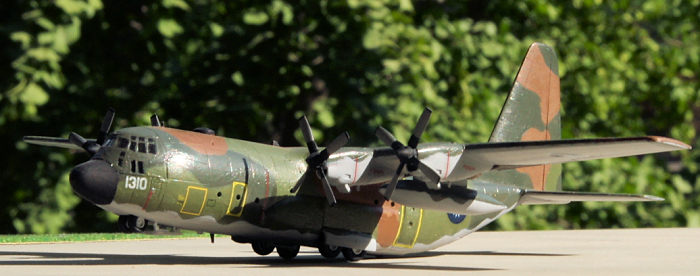
earthquake there. Of course, this was as much a political statement as a
humanitarian one. Haiti was one of the few countries which recognised Taiwan
instead of the PRC as "China". Having supplies flown 15,000km is one of the
few fringe benefits of doing that.
A few quick stats on the Hercules. It's been in production since 1954 and
2,500 have been built so far. The H model variants accounted for 1,202 of
those. The basic H model you see here can carry 92 passengers, or 64
paratroopers, or 452 people desperate to get out of Saigon, or 2-3 Humvees,
or 2 M113 armoured vehicles, or a Sheridan light tank. It's served with
about 70 countries, a few companies, and apart from the standard cargo
plane, the Hercules can be configured as a tanker, a SAR plane, a
reconnaissance aircraft, a gunship, and for special operations support.
This is Hasegawa's classic 1/200 C-130 kit which has appeared in many
boxings over the years. This twin pack gives you JASDF options - an overall
tactical grey version and a three tone camouflage version. This boxing is
very similar to 10565, right down to the cover photo. The difference is that
the camouflage aircraft in 10565 comes with decals to make a white tailed UN
version. This boxing does not, but oth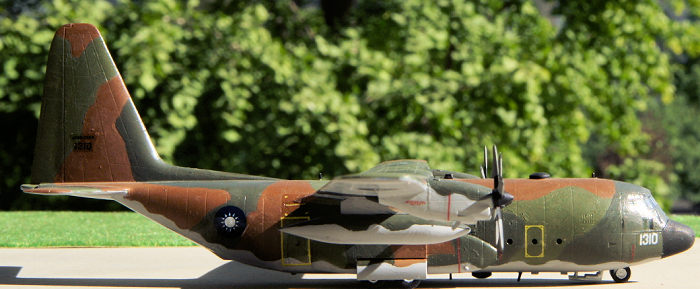 erwise
they're identical. There are other boxings, including single-packs, of
JASDF, USAF, USMC ("Fat Albert"), Belgian and RAF C-130s (with extra parts).
You can also get an AC-130, but after Kunduz I can't say I'm too keen on
that. For me the coolest thing about the Hercules is its cargo hauling and
humanitarian capabilities; supplying hospitals rather than, well, blowing
them up.
erwise
they're identical. There are other boxings, including single-packs, of
JASDF, USAF, USMC ("Fat Albert"), Belgian and RAF C-130s (with extra parts).
You can also get an AC-130, but after Kunduz I can't say I'm too keen on
that. For me the coolest thing about the Hercules is its cargo hauling and
humanitarian capabilities; supplying hospitals rather than, well, blowing
them up.
Some time ago, the kit was
previewed
right here on MM. The sprues in my boxing are just the same as those you
see in the preview, except one of the two kits is moulded in a kind of blue
grey plastic, presumably so kids in Japan can make the tactical version
without painting it.
If you can't be bothered clicking the link, basically this is a nicely
moulded kit with engraved panel lines, empty window holes, and a cargo door
you can pose open to see the non-detailed interior. There is a cockpit
bulkhead but no interior detail, and it comes with a stand.
Assuming you don't want to scratch build a cockpit in 1/200 scale, you can
simply assemble the floor and back wall and install them straight into one
side of the fuselage. I painted that area black and the rest of the interior
an interior green colour. Before racing ahead to seal up the fuselage be
sure to put in the two main wheel wells - they install from the inside.
You need nose weight. Without it, the plane will still sit on its wheels,
but with nose weight, it actually takes some weight on the nose wheel. I
didn't do that on one of my three C-130 builds and you can tell the
difference. 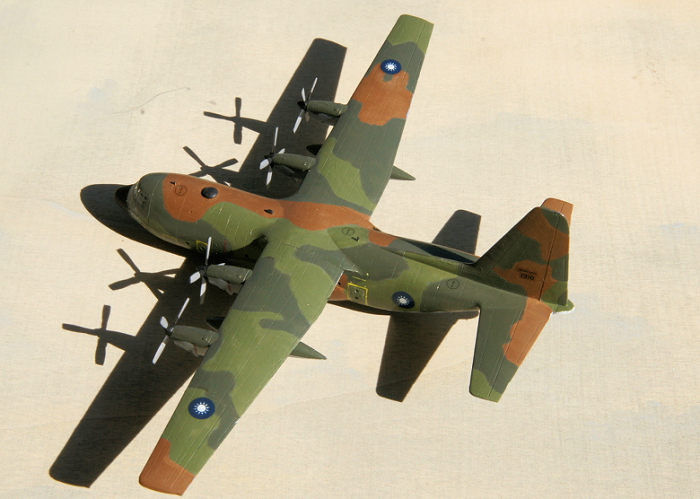
If you've decided to pose the cargo door open, paint the inside of the cargo
bay and consider whether you want to add any detail inside. It's small and
dark but you could see some extra work around the opening.
Though these moulds must have punched out thousands of these little Hercules
everything is in good shape and the kit fits together very well. I didn't
use filler anywhere, though perhaps a little here and there might have
helped. Instead, I just sanded off a few of the seams where needed (if
you're more careful a builder than me, you'll want to focus on the engine
pods). The front windows of the plane are one large clear piece and it does
leave a line which you can see in one or two of the photos. Remember,
though, that this model is smaller than a 1/72 Spitfire: your own eyes don't
see the real thing quite as big as it looks in close up photos.
The Taiwanese planes, based on pics I saw online, have a prominent radome on
the bottom as well as the more familiar one on the top. Luckily, the other
C-130 in this box is destined to be a plane that didn't have the top radome,
so I simply took that for the underside although to be strictly truthful
it's a bit big (at least based on the photos of the real thing). You need to
also paint up the various little antenna underneath, and be careful not to
snap them off when building.
I have already built the pretty cool JASDF camo C-130 that comes in this
boxing. The grey one is pretty boring to look at. So I fished around for an
alternative scheme and somehow I came up with the Taiwanese version, using
decals from Bestfong. Their 1/200 RoCAF C-130 set - number 200001 - was
previewed right here on MM not too long ago.
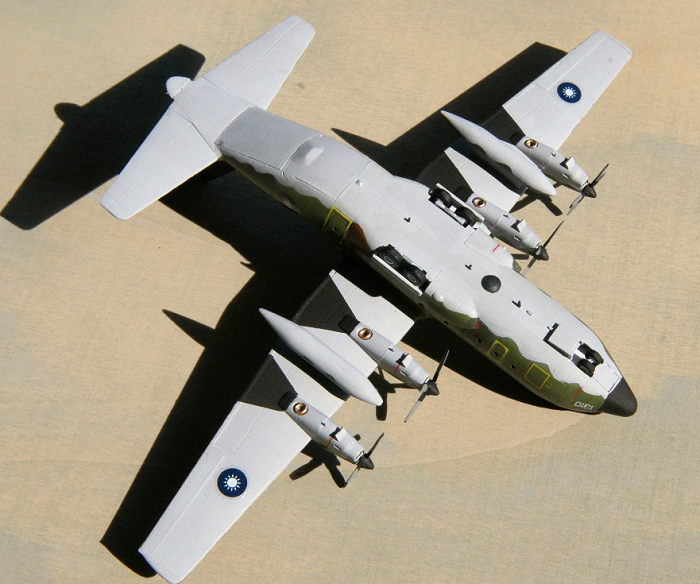
As
I said in the decal preview, this is a neat set and it comes with a handy
colour three-view painting guide. The greens are Mr Color 303 and 309, the
brown is 310 and the grey underneath is 307.
I already had the the greens, but not the grey or the brown. My local shop,
true to form, didn't have them either, so I ended up using Vallejo - 70.989
Sky Grey and 70.983 Flat Earth. Of course, the Mr Color are semi gloss and
the Vallejo are very flat, but unless you shine a bright light directly on
the model, they are actually roughly a similar sheen, as you can see in the
photos. I brush painted the model, with three coats of the Mr Color and two
of the Vallejos. I freehanded the wavy grey demarcation line, as well as the
camo scheme itself. But I masked the black areas under the wings behind the
engines, and also the radome. I used Vallejo for the black.
Painting a scheme like this is pretty straightforward if you take your time
and try to follow the pattern shown on the instructions. I never worry too
much if I don't replicate it perfectly, but I just use panel lines as a
rough guide for where my colours should change. For the exhaust vents under
the engine pods, I used Tamiya gold ti get the metallic effect, mixed with
some brown to get the colour I wanted. I don't really know what those parts
would look like in reality, so I went with "generic scale model exhaust pipe
colour".
The Bestfong decals work quite well. The RoCAF roundels look better on the
plane than they do on the sheet, and the other markings are nicely done. I
found that they were a bit resistant to Mr Mark Softer, and so in bright
light there is still a bit of silvering on them. I also used one or two of
the Hasegawa decals, for example on the forward yellow door on the left side
of the fuselage.
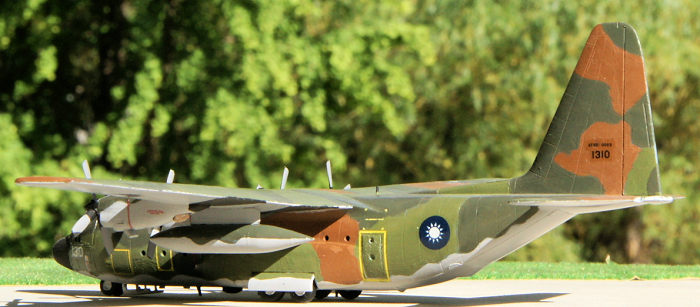 This
decal sheet gives you a whole decal for serial 1310, and individual numbers
for the other 19 serials flown by the RoCAF. As they are really tiny, I
decided to go with the whole decal, and make 1310, rather than piece
together four small numbers for a different aircraft. According to the
serial cross reference you get with the instructions, 1310 has the smaller
tail number 85-0022. Unfortunately, it seems Bestfong didn't print the 0022
- it goes 0020, 0021, 0023! These numbers are about a millimeter high so I
just used the 0023. At this size, I can live with it very comfortably. You
need a microscope to see the number anyway.
This
decal sheet gives you a whole decal for serial 1310, and individual numbers
for the other 19 serials flown by the RoCAF. As they are really tiny, I
decided to go with the whole decal, and make 1310, rather than piece
together four small numbers for a different aircraft. According to the
serial cross reference you get with the instructions, 1310 has the smaller
tail number 85-0022. Unfortunately, it seems Bestfong didn't print the 0022
- it goes 0020, 0021, 0023! These numbers are about a millimeter high so I
just used the 0023. At this size, I can live with it very comfortably. You
need a microscope to see the number anyway.
After I finished the decals, I just had to add the windscreen, paint its
framework, and then put on the wheels and props. I also go to the end and
realised I hadn't installed the rear door, so that was just about my last
step.
I love these little 1/200 Hercules - if there were enough decals available I
could go on building them all the time. With these markings from Bestfong,
you can have a Hercules in a nice camouflage scheme and an unusual air force
on your shelf - all in the footprint of a 1/72 Spitfire.
Richard F
16 May 2017
Copyright ModelingMadness.com
If you would like your product reviewed fairly and fairly quickly, please
contact
the editor or see other details in the
Note to
Contributors.
Back to the Main Page
Back to the Review
Index Page
Back to the Previews Index Page


 Taiwan is
a pretty small place, so one might ask why it needs 20 C-130s. Well, one was
converted to an electronic warfare platform, which makes sense, and of
course every air force needs to move cargo from base to base. Spare parts
here, crew there, and so on. The C-130s could be fitted as tankers, but this
is a touchy subject with the People's Republic of China (PRC) which, of
course, claims Taiwan as a (renegade) province. Tankers turn defensive
fighters like Taiwan's Mirage 2000s into long range attack aircraft.
Taiwan is
a pretty small place, so one might ask why it needs 20 C-130s. Well, one was
converted to an electronic warfare platform, which makes sense, and of
course every air force needs to move cargo from base to base. Spare parts
here, crew there, and so on. The C-130s could be fitted as tankers, but this
is a touchy subject with the People's Republic of China (PRC) which, of
course, claims Taiwan as a (renegade) province. Tankers turn defensive
fighters like Taiwan's Mirage 2000s into long range attack aircraft. earthquake there. Of course, this was as much a political statement as a
humanitarian one. Haiti was one of the few countries which recognised Taiwan
instead of the PRC as "China". Having supplies flown 15,000km is one of the
few fringe benefits of doing that.
earthquake there. Of course, this was as much a political statement as a
humanitarian one. Haiti was one of the few countries which recognised Taiwan
instead of the PRC as "China". Having supplies flown 15,000km is one of the
few fringe benefits of doing that. erwise
they're identical. There are other boxings, including single-packs, of
JASDF, USAF, USMC ("Fat Albert"), Belgian and RAF C-130s (with extra parts).
You can also get an AC-130, but after Kunduz I can't say I'm too keen on
that. For me the coolest thing about the Hercules is its cargo hauling and
humanitarian capabilities; supplying hospitals rather than, well, blowing
them up.
erwise
they're identical. There are other boxings, including single-packs, of
JASDF, USAF, USMC ("Fat Albert"), Belgian and RAF C-130s (with extra parts).
You can also get an AC-130, but after Kunduz I can't say I'm too keen on
that. For me the coolest thing about the Hercules is its cargo hauling and
humanitarian capabilities; supplying hospitals rather than, well, blowing
them up.
 As
I said in the decal preview, this is a neat set and it comes with a handy
colour three-view painting guide. The greens are Mr Color 303 and 309, the
brown is 310 and the grey underneath is 307.
As
I said in the decal preview, this is a neat set and it comes with a handy
colour three-view painting guide. The greens are Mr Color 303 and 309, the
brown is 310 and the grey underneath is 307. This
decal sheet gives you a whole decal for serial 1310, and individual numbers
for the other 19 serials flown by the RoCAF. As they are really tiny, I
decided to go with the whole decal, and make 1310, rather than piece
together four small numbers for a different aircraft. According to the
serial cross reference you get with the instructions, 1310 has the smaller
tail number 85-0022. Unfortunately, it seems Bestfong didn't print the 0022
- it goes 0020, 0021, 0023! These numbers are about a millimeter high so I
just used the 0023. At this size, I can live with it very comfortably. You
need a microscope to see the number anyway.
This
decal sheet gives you a whole decal for serial 1310, and individual numbers
for the other 19 serials flown by the RoCAF. As they are really tiny, I
decided to go with the whole decal, and make 1310, rather than piece
together four small numbers for a different aircraft. According to the
serial cross reference you get with the instructions, 1310 has the smaller
tail number 85-0022. Unfortunately, it seems Bestfong didn't print the 0022
- it goes 0020, 0021, 0023! These numbers are about a millimeter high so I
just used the 0023. At this size, I can live with it very comfortably. You
need a microscope to see the number anyway.